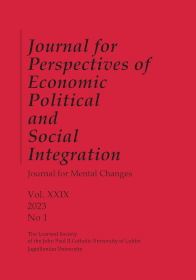Metadata of Patent Information in the Value Assessment of New Technology Solutions
Abstract
This study aims to discuss the possibility of an aggregated value assessment of a new technology solution on various levels: an entity (organization), specific technology field, regional economy, national economy, the economy of an integration group, and to test that assessment method using a transnational approach. In addition to testing the possibility and purposefulness of an aggregated assessment of new technology solutions in a group of countries, the study is aimed to test the hypothesis on a large technology quality gap between the German economy and those of other member states of the European Union.
To achieve the objective of this study and verify the proposed hypothesis, the nature of invention and potential of patent information in the testing of technology value are discussed, and a taxonomic indicator is devised, suitable for achieving the objective and verifying the hypothesis.
The presented results of an original study show a dramatic difference in the value of new technical solutions between Germany and EU13, but also between Germany and EU14. New technical solutions originating from the EU13 region are barely observable to other global R&D centres.
The scope of the research process presented in this article indirectly addresses two issues: using patent information to describe the patterns of technological accumulation and selecting and positioning smart specialization.
References
Alcacer, J., & Gittelman, M. (2006). Patent citations as a measure of knowledge flows: The influence of examiner citations. The Review of Economics and Statistics, 88(4), 774–779.
Arrow, K. J. (1962). Economic welfare and the allocation of resources for invention. In The Rate and Direction of Inventive Activity: Economic and Social Factors (pp. 609–626). Princeton University Press.
Criscuolo, P., & Verspagen, B. (2008). Does it matter where patent citations come from? Inventor vs. examiner citations in European patents, Research Policy, 37(10), 1892–1908.
Dykas, P., Kościelniak, P., & T. Tokarski (2013). Taksonomiczne wskaźniki rozwoju ekonomicznego województw i powiatów [Taxonomic indicators of economic growth of voivodeships and powiats]. In M. Trojak & T. Tokarski (Eds.), Statystyczne analiza przestrzennego zróżnicowania rozwoju ekonomicznego i społecznego Polski [Statistical analysis of the spatial diversification of economic and social development of Poland]. Wydawnictwo Uniwersytetu Jagiellońskiego.
Freeman, C. (1982). The economics of industrial innovation. MIT Press.
Freeman, C. (1987). Technology policy and economic performance: Lessons from Japan. Pinter.
Gomułka, S. (1998). Teoria innowacji i wzrostu gospodarczego. CASE.
Griliches, Z. (1990). Patent statistics as economic indicators: A survey. Journal of Economic Literature, 28, 1661–1707.
Guellec, D., & Pottelsberghe de la Potterie, B. van (2007). The economics of the European Patent System: IP policy for innovation and competition. Oxford University Press.
Hall, B. H., & Harhoff, D. (2012). Recent research on the economics of patents (NBER Working Paper No. 17773). National Bureau of Economic Research. www.nber.org/papers/w17773
Hall, B. H., Jaffe, A., & Trajtenberg, M. (2001a). Market value and patent citations: A first look (Economics Department Working Paper No. E00-277). University of California.
Hall, B. H., Jaffe, A., & Trajtenberg, M. (2001b). The NBER patent citation data file: Lessons, insights and methodological tools (NBER Working Paper No. 8498). National Bureau of Economic Research. www.nber.org/papers/w8498.
Hall, B. H., Jaffe, A., & Trajtenberg, M. (2005). Market value and patent citations. Rand Journal of Economics, 36(1), 16–38.
Harhoff, D., Scherer, F. M., & Vopel, K. (2003). Citations, family size, opposition and the value of patent rights. Research Policy, 32(8), 1343–1363.
Kuhn, T. S. (1973). The structure of scientific revolutions. University of Chicago Press.
Lanjouw, J. O., Pakes, A., & Putnam, J. (1998). How to count patents and value intellectual property: The uses of patent renewal and application data. Journal of Industrial Economics, 46(4), 405–432.
Lanjouw, J., & Schankerman, M. (2004). Patent quality and research productivity: Measuring innovation with multiple indicators. The Economic Journal, 114(495), 441–465.
Machlup, F. (1958). An economic review of the patent system, study of the Subcommittee on Patents, Trademarks, and Copyrights of the Committee on the Judiciary US Senate, 85th Congress, 2nd Session, Study No 15. US Government Printing Office.
Nowicka, A., du Vall, M., & Żakowska-Henzler, H. (2010). Ochrona wynalazków i wzorów użytkowych. In A. Adamczak & M. du Vall (Eds.), Ochrona własności intelektualnej. Uniwersytecki Ośrodek Transferu Technologii UW.
OECD. (2009). OECD Patent Statistics Manual. OECD Publishing. http://doi.org/10.1787/9789264056442-en
OECD. (2017). What Indicators for Science, Technology and Innovation Policies in the 21st Century? Retrieved August 30, 2022, from https://www.oecd.org/science/inno/37082579.pdf
Scherer, F. M. (1965). Firm size, market structure, opportunity, and the output of patented inventions. American Economic Review, 55(5), 1097–1125.
Schmookler, J. (1966). Invention and economic growth. Harvard University Press.
Squicciarini, M., Dernis, H., & Criscuolo, C. (2013). Measuring patent quality: Indicators of technological and economic value (OECD Science, Technology and Industry Working Papers, No. 2013/03). OECD Publishing. https://doi.org/10.1787/5k4522wkw1r8-en
Copyright (c) 2023 Journal for Perspectives of Economic Political and Social Integration

This work is licensed under a Creative Commons Attribution-NonCommercial-NoDerivatives 4.0 International License.

